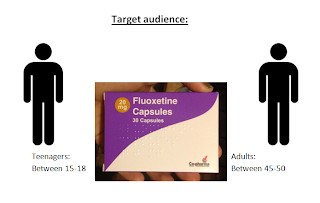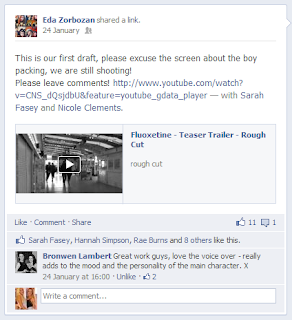What have you learnt through audience feedback?
 When deciding on a target market for our trailer, we realised we had two. The first one is teenagers aged between 15-18 and our second is the older generation of about 40-55 years of age. We had two target markets due to the protagonistbeing a teenager meaning teenagers would be attracted to watching the film and also because our theme of mods would relate to the older generation due to them being part of the mod era. This generation would want to watch the film to reminisce the 1960s due to the music in our trailer and the references to Quadrophenia.
When deciding on a target market for our trailer, we realised we had two. The first one is teenagers aged between 15-18 and our second is the older generation of about 40-55 years of age. We had two target markets due to the protagonistbeing a teenager meaning teenagers would be attracted to watching the film and also because our theme of mods would relate to the older generation due to them being part of the mod era. This generation would want to watch the film to reminisce the 1960s due to the music in our trailer and the references to Quadrophenia.
Audience feedback is important as it is a way of getting opinions and views from people on our media products. We tried to gain as much feedback as possible throughout the process so that we could create a trailer that was targeted to both of our target markets. Without audience feedback we wouldn't have known what people other than our group members thought of our trailer, meaning it wouldn't have been closely related to our target audiences.
The two main ways of gaining feedback are by interview and questionnaires. Interviews can be one to one or by using focus groups, questionnaires can use different question types for example; tick boxes, number ordering and giving descriptions.
Interviews and focus groups are beneficial as you can achieve:
-Personaliseddetailed responses
-Can see the reactions and facial expressions of the viewer
-Interactwith the viewer to develop their answers.
The down side to using focus groups and interviews is that they can be
-time consuming
· a wide group of people may be hard to access
-Spoken data can be difficult to process into graphs for results.
Questionnaires are beneficial as they are
-anonymous
-carried out individually
-quick to fill out
-easy to translate the data into graphs,
The down falls are that
-the responder may not have fully understood the question so the answers may not be what we were looking for
-The viewer is restricted to the amount of detail they can give in their answer.
 When gaining audience feedback we used both interviews and questionnaires. When interviewing, we used a focused group of five 17-18 year olds of both gender. We gave them a brief introduction to our trailer and then played it. Afterwards we engaged in a discussion with them asking a range of questions. The discussion went well as once we had asked a question we could ask them to explain and develop their answers. We videoed the focus group both watching the trailer, for their reactions and also the discussion after. We learnt a lot from the discussion and improved most of the negative points, for example they didn't like the positioning of the voice over so we moved it a little. (http://youtu.be/nU4eybaN0eQ a link to our focus group video)
When gaining audience feedback we used both interviews and questionnaires. When interviewing, we used a focused group of five 17-18 year olds of both gender. We gave them a brief introduction to our trailer and then played it. Afterwards we engaged in a discussion with them asking a range of questions. The discussion went well as once we had asked a question we could ask them to explain and develop their answers. We videoed the focus group both watching the trailer, for their reactions and also the discussion after. We learnt a lot from the discussion and improved most of the negative points, for example they didn't like the positioning of the voice over so we moved it a little. (http://youtu.be/nU4eybaN0eQ a link to our focus group video)
We also had a trailer showing for around 30 people aged between 16-18 both male and female. During the screening we gave each viewer a questionnaire for them to fill out after watching. The questionnaire included seven questions in a range of tick boxes, circles and explanation questions. The viewing was very useful as the questionnaires gave us important information we could use to make improvements of our trailer. A benefit of this showing was that as well as the viewers being within our target audience, they were also media students meaning they're feedback was very relevant to the sound, miss en scene and editing.
 Another way we gained audience feedback was by sharing our trailer from YouTube via social networking sitessuch as Facebook and Twitter. This was beneficial as we could reach a wider target audience other than people in our own age group and from our area. By sharing on YouTube, Facebook and Twitter we gained feedback in the form of comments and ‘likes.’ We learnt a lot from the comments as people gave their opinions on what was their favourite part and also included some constructive criticism for us to work on. However the videos we shared on Facebook could only be seen by our friends meaning the scope of the viewers wasn't as wide as it could have been. therefore we also shared them via twitter and YouTube as they could then be seen by anyone.
Another way we gained audience feedback was by sharing our trailer from YouTube via social networking sitessuch as Facebook and Twitter. This was beneficial as we could reach a wider target audience other than people in our own age group and from our area. By sharing on YouTube, Facebook and Twitter we gained feedback in the form of comments and ‘likes.’ We learnt a lot from the comments as people gave their opinions on what was their favourite part and also included some constructive criticism for us to work on. However the videos we shared on Facebook could only be seen by our friends meaning the scope of the viewers wasn't as wide as it could have been. therefore we also shared them via twitter and YouTube as they could then be seen by anyone.
After gaining all our audience feedback from the focus group, questionnaires and comments on social networking sites we configured a list of areas, both positive and negative, which were mentioned frequently.
Positives:
-Protagonist fitted well
-Blowing out smoke shot
-The two contrasting locations
-End credits
-The actors names being in the book
-Voice over
Negatives:
-Running in the dark
-Secondvoice over
-Muted sound at the end
From this list it is clear there are more positives to negatives which is pleasing, however there were still some negatives. We tried are hardest to change the negatives, for example we changed the contrast of the running in the dark shots so they were clearer and we also edited the sound so that it didn't mute, instead we ducked it under the voice over. However the negative feedback on the second voice over we decided not to change because without it the first part of the voice over wouldn't make sense, and this part was seen as a positive by viewers.
Overall we learnt a huge amount from audience feedback because it was so varied and gave us a huge insight to what people other than our group members thought of the Fluoxetine trailer. It also helped us improve the trailer further by fixing some of the frequent negative points. Our audience feedback is important as we wanted our trailer to please our target audience and the only way to know if we were doing this is by showing it to them as we went. By doing this, as a group we feel as though the trailer fits the targets audience’s preferences and opinions well.


No comments:
Post a Comment